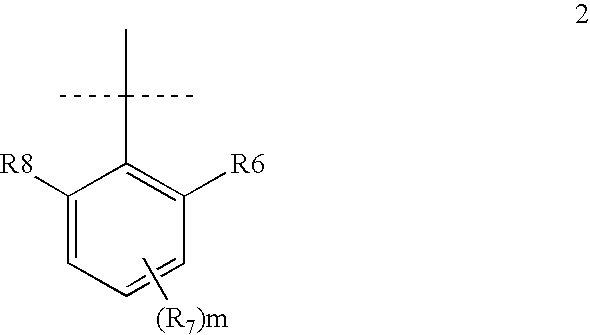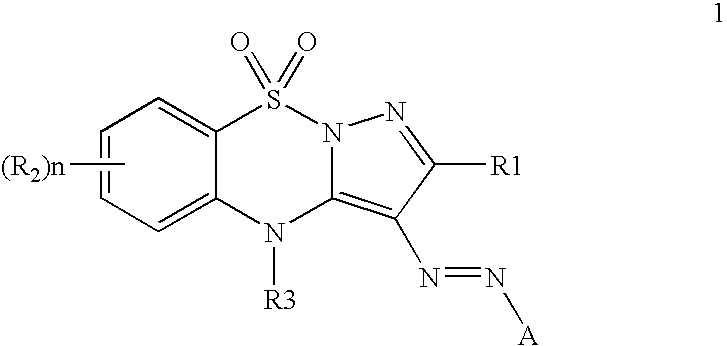Monoazo colorants from pyrazolobenzodiazinedioxides
a technology of pyrazolobenzodiazinedioxide and monoazo colorants, which is applied in the field of new colorants and their use in inks, can solve the problems of image fastness problems, colorants currently in commercial aqueous ink formulations are less than optimal in one property, and it is difficult to find colorants which possess all of the above attributes, so as to improve the probability, and improve the effect of color stability
- Summary
- Abstract
- Description
- Claims
- Application Information
AI Technical Summary
Benefits of technology
Problems solved by technology
Method used
Image
Examples
Embodiment Construction
[0040]This invention provides an ink composition comprising a colorant represented by Formula 1:
[0041]
wherein R1 and R2 may be hydrogen or any non-metallic group; n may be 0-4.
[0042]R3 may be hydrogen, acyl, aryl, alkenyl, alkynyl or alkyl. Some examples of suitable substituent groups for R3 are: formyl, acetyl, benzoyl, phenyl, substituted phenyl, methyl, ethyl, propyl, butyl, and allyl.
[0043]A represents a substituted or unsubstituted aromatic heterocyclic ring; or A may be an aromatic group of Formula 2:
[0044]
[0045]where R6 and R8 may each independently be hydrogen, alkyl, sulfonic acid, or 1-4 carbon alkoxy; R7 may be any non-metallic group; m is an integer from 0-3; R6 and R7, R7 and R8, or, when m>1, two R7 groups may be joined to form a fused carbocyclic or heterocyclic aromatic or non-aromatic ring that can be further substituted.
[0046]This invention further provides inks for printing wherein the ink contains a colorant of Formula 1:
[0047]
wherein R1 and R2 may be hydrogen or...
PUM
| Property | Measurement | Unit |
|---|---|---|
| viscosities | aaaaa | aaaaa |
| viscosities | aaaaa | aaaaa |
| surface tensions | aaaaa | aaaaa |
Abstract
Description
Claims
Application Information
 Login to View More
Login to View More - R&D
- Intellectual Property
- Life Sciences
- Materials
- Tech Scout
- Unparalleled Data Quality
- Higher Quality Content
- 60% Fewer Hallucinations
Browse by: Latest US Patents, China's latest patents, Technical Efficacy Thesaurus, Application Domain, Technology Topic, Popular Technical Reports.
© 2025 PatSnap. All rights reserved.Legal|Privacy policy|Modern Slavery Act Transparency Statement|Sitemap|About US| Contact US: help@patsnap.com



